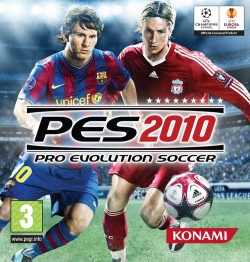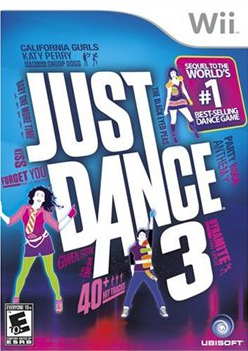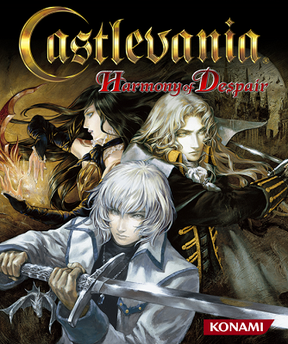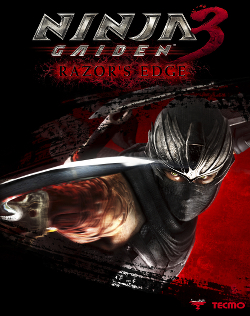
Tekken 6 is a fighting game developed and published by Bandai Namco Games. It is the sixth main and seventh overall installment in the Tekken franchise. It was released in arcades on November 26, 2007, as the first game running on the PlayStation 3-based System 357 arcade board. A year later, the game received an update, subtitled Bloodline Rebellion. Both versions also saw a limited release in North America. A home version based on the update was released for the PlayStation 3 and Xbox 360 on October 27, 2009. This was the first time a main installment was produced for another console. It was ported for the PlayStation Portable on November 24, 2009. The game was produced by Katsuhiro Harada, who aimed to give the fights a strategic style while remaining faithful to the previous games in the series.
The seventh generation of home video game consoles began on November 22, 2005, with the release of Microsoft's Xbox 360 home console. This was followed by the release of Sony's PlayStation 3 on November 17, 2006, and Nintendo's Wii on November 19, 2006. Each new console introduced new technologies. The Xbox 360 offered games rendered natively at high-definition video (HD) resolutions, the PlayStation 3 offered HD movie playback via a built-in 3D Blu-ray Disc player, and the Wii focused on integrating controllers with movement sensors as well as joysticks. Some Wii controllers could be moved about to control in-game actions, which enabled players to simulate real-world actions through movement during gameplay. By this generation, video game consoles had become an important part of the global IT infrastructure; it is estimated that video game consoles represented 25% of the world's general-purpose computational power in 2007.

WWE SmackDown vs. Raw 2009 is a professional wrestling video game developed by Yuke's and published by THQ for the PlayStation 3, PlayStation 2, PlayStation Portable, Wii, and Xbox 360 video game consoles, with TOSE overseeing development for the Nintendo DS version. The game was first released on November 9, 2008 in North America. It is the tenth overall installment in the video game series based on the World Wrestling Entertainment (WWE) promotion, and the fifth game under the SmackDown vs. Raw name, named after the promotion's Raw and SmackDown brands. It is the sequel to 2007's SmackDown vs. Raw 2008 and the second game to feature the promotion's ECW brand.
Hasbro Family Game Night is a series of video games that adapt board games manufactured by Hasbro.

No More Heroes 2: Desperate Struggle is an action-adventure hack and slash video game developed by Grasshopper Manufacture for the Wii. The sequel to No More Heroes (2007), it was released by Marvelous Entertainment in Japan, Ubisoft in North America and Rising Star Games in PAL territories in 2010. The game continues the story of professional assassin Travis Touchdown; upon discovering that a corporation's CEO placed a hit on his best friend, Travis rejoins the ranks to fight his way through an even greater number of assassins to confront his best friend's killer and attain revenge.

Madden NFL 10 is an American football video game based on the National Football League that was published by EA Sports and developed by EA Tiburon. The 21st installment of the Madden NFL series, it is the first game to feature two players on the cover: Troy Polamalu of the Pittsburgh Steelers and Larry Fitzgerald of the Arizona Cardinals, who played against each other the previous season in Super Bowl XLIII. It was released in August 2009 for the PlayStation 2, PlayStation 3, PlayStation Portable, Wii, Xbox 360 and BlackBerry, and for the iOS on September 9 through the App Store.

WWE SmackDown vs. Raw 2010 is a professional wrestling video game developed by Yuke's and published by THQ for PlayStation 2 (PS2), PlayStation 3 (PS3), PlayStation Portable (PSP), Wii, Nintendo DS, Xbox 360, and iOS. It was released worldwide in October 2009, with the PS3 and Xbox 360 versions for Japan in January 2010. TOSE oversaw the development for the Nintendo DS version, which was the last installment to be released for the handheld. 2010 was also the first installment to be released as an iPhone app, launching on App Store on December 23 the same year.

Pro Evolution Soccer 2010 is the ninth football video game in the Pro Evolution Soccer series. The game was developed and published by Konami for release on Sony's PlayStation 2, PlayStation 3, and PlayStation Portable; Microsoft's Xbox 360 and Windows; Nintendo's Wii; and mobile phones.

Dance Dance Revolution, released in Europe as Dance Dance Revolution Hottest Party 4 for the Wii version and Dance Dance Revolution New Moves for other versions, is a music video game in the Dance Dance Revolution series, with this entry developed by Konami's American division. Unveiled at E3 2010, it was released for the Wii and PlayStation 3 in North America on November 16, 2010. A port of this version for the Xbox 360 was also released on April 12, 2011. It is also the only game in the series to be released for the PlayStation 3, as well as the final game in the series to be released for the Xbox 360.

Toy Story 3 is a 2010 platform game developed by Avalanche Software and published by Disney Interactive Studios. The game is based on the 2010 film of the same name. It was released for PlayStation 3, Xbox 360, Wii, and Microsoft Windows. The game was ported to OS X by TransGaming. A Nintendo DS version was developed by n-Space, while Disney Mobile Studios developed and published an iOS game based on the film. Another version was developed by Asobo Studio and released for PlayStation 2 and PlayStation Portable.

MySims SkyHeroes is a video game developed by Behaviour Interactive and published by Electronic Arts. It is the sixth and final game in the MySims series. The game was released in 2010 for the Nintendo DS, PlayStation 3, Wii, and Xbox 360.

WWE SmackDown vs. Raw 2011 is a professional wrestling video game developed by Yuke's and published by THQ for PlayStation 2 (PS2), PlayStation 3 (PS3), PlayStation Portable (PSP), Xbox 360, and Wii systems. The game was released worldwide in October 2010, with the PS3 and Xbox 360 versions for Japan in February 2011.

Just Dance 3 is a 2011 dance rhythm game released on the Wii, Xbox 360, and PlayStation 3 with Kinect and Move support respectively for the latter two. It is part of the Just Dance video game series published by Ubisoft originally on the Wii and the third main installment of the series. Just Dance 3 was announced shortly after the release of Just Dance 2 and was released for the Wii and Xbox 360 on October 7, 2011 in North America and October 11, 2011 in Australia and Europe and for the PlayStation 3 on December 6, 2011 in North America, December 8, 2011 in Australia and December 9, 2011 in Europe. Just Dance 3 received positive reviews from critics and is the best-selling third-party Wii game of all-time, with sales of 9.92 million.

Castlevania: Harmony of Despair is a multiplayer-focused platform-adventure game in the Castlevania series, featuring an ensemble cast of characters from the 2-D Metroidvania era of games, developed and published by Konami for Xbox 360 in August 2010, and for PlayStation 3 in 2011.

Hard Corps: Uprising is a run and gun video game developed by Arc System Works and published by Konami for the Xbox 360 and the PlayStation 3. The game was released digitally on Xbox Live Arcade on February 16, 2011 and on the PlayStation Network in March 2011. In Hard Corps: Uprising, the player assumes the role of an elite soldier simply called Bahamut, along with other main characters. Konami has added three additional player characters via downloadable content.

Virtua Tennis 4, known in Japan as Power Smash 4, is the third sequel to Sega's tennis game franchise, Virtua Tennis. It was released on PlayStation 3, Xbox 360, Microsoft Windows, Wii and PlayStation Vita. This is the first main series Virtua Tennis game to not have an arcade release before the console releases. An arcade version was also released, which is powered by the PC-based Sega RingEdge arcade system. There are two versions of the cabinet: an upright 4-player cabinet, and a deluxe 4-player cabinet.

No More Heroes is an action-adventure hack and slash video game developed by Grasshopper Manufacture for the Wii. It was released by Marvelous Entertainment in Japan in 2007, Ubisoft in North America and Rising Star Games in PAL territories in 2008. The game was directed, designed, and written by Goichi Suda, also known by his nickname Suda51. The game follows Travis Touchdown, an otaku who wins a beam katana in an auction, from which he inadvertently becomes involved in the United Assassins Association and forced to kill assassins higher in rank to prevent other assassins from targeting him.

Pro Evolution Soccer 2013 is an association football video game, developed and published by Konami. The game was announced by Konami on April 18, 2012. For the first time of the series, all 20 teams from the Brazilian national league, Campeonato Brasileiro Serie A, are included in the game series. The UEFA Champions League and UEFA Europa League features in the game. PES 2013 was the last game in the series available on a Nintendo home console and was succeeded by Pro Evolution Soccer 2014.

Ninja Gaiden 3: Razor's Edge is a 2012 action adventure hack and slash game developed by Team Ninja and published by Nintendo. It was released for the Wii U from November 2012 to May 2013, and subsequently released by Tecmo Koei for the PlayStation 3 and Xbox 360 in April 2013. It is an enhanced port of Ninja Gaiden 3 that includes all downloadable content from the original title, as well as additional enhancements made to improve the game. The game can be considered an equivalent to the Ninja Gaiden Sigma games, as it makes several changes to the original title.

No More Heroes is an action-adventure hack and slash video game series developed by Grasshopper Manufacture and was created by Goichi Suda, also known by his nickname Suda51. The series' title comes from the album title No More Heroes, which was released by the British punk band The Stranglers. The games follows Travis Touchdown, a fan of video games, anime, manga and wrestling who wins a beam katana in an auction, from which he inadvertently becomes involved in the United Assassins Association and forced to kill assassins higher in rank to prevent other assassins from targeting him.





















